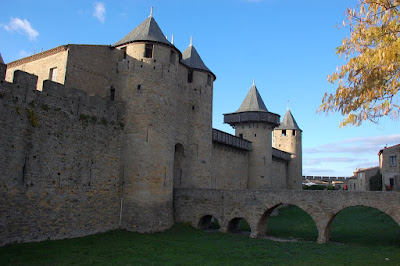 |
| The Cite from the bridge |
We spent there a great deal of time at Carcassonne - browsing through the Fortress and the city, having unhurried lunch and breaks, having caught the sunset that made the castle gleam under the light!
Designated as a UNESCO World Heritage Site it is a fortified medieval French town, complete with a Castle, a fortress, a basilica, the ramparts. The hilltop was identified as a strategic location by the Romans and the Colonia Julia Carcase was established here between 43 and 30 B.C. In 462 the Romans officially ceded the western colonies to the Visigoths; he built more fortifications at Carcassonne: traces of them still stand. Saracens from Barcelona took Carcassonne in 725. King Pepin the Short drove them away in 759-60 he was unable to penetrate the impregnable fortress of Carcassonne.
In 1067 Carcassonne became the property of Count Trencavel through his marriage. Carcassonne became famous in its role in the Albigensian Crusades, when the city was a stronghold of Occitan Cathars. In August 1209 the crusading army of Simon de Montfort forced its citizens to surrender. After capturing Trencavel, imprisoning him and allowing him to die, Montfort made himself the new viscount. He added to the fortifications. Carcassonne became a border citadel between France and the kingdom of Aragon (Spain). The city submitted to the rule of the kingdom of France in 1247, and King Louis IX founded the new part of the town across the river. He and his successor Philip III built the outer ramparts.
In 1659, the Treaty of the Pyrenees transferred the border province of Roussillon to France, and Carcassonne's military significance was reduced. Fortifications were abandoned, and the city became mainly an economic center that concentrated on the woollen textile industry.
Carcassonne was struck from the roster of official fortifications under Napoleon and the Restoration, and the fortified cité fell into such disrepair that the French government decided that it should be demolished in 1859. The mayor of Carcassonne, Jean-Pierre Cros-Mayrevieille, and the writer Prosper Mérimée, the first inspector of ancient monuments, led a campaign to preserve the fortress as a historical monument. Later in the year the architect Eugène Viollet-le-Duc was commissioned to renovate the place. Carcassonne is agreed to be a work of his genius, though not of strictest authenticity.
Credits: Wikipedia
This is a rare case of pictures being worth a thousand of words...




No comments:
Post a Comment